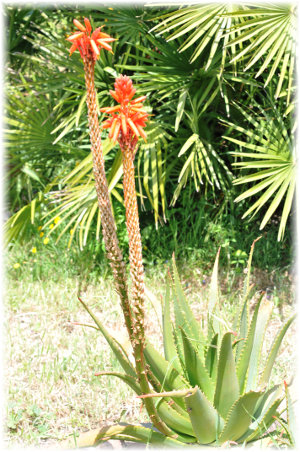


Aloe vera - Aloe barbadensis miller (Xanthorrhoeaceae, subfamily Asphodeloideae - lily family) Characteristics and uses:
Etymology: Aloe "vera" means "true" or "genuine" aloe. Barbadensis comes from Barbados Island, and Miller is the surname of the famous English botanist. Other uses: Aloe vera gel is used commercially as an ingredient in beverages, yogurts, desserts. It is used in traditional medicine as a multipurpose skin treatment, in makeup, soaps, sunscreens, shaving cream, shampoos, moisturizer, tissues, and in many hygiene products, because of its "moisturizing emollient effect". Use of topical aloe vera is not associated with significant side effects. History and folklore: The species was first described by Carl Linnaeus in 1753, but employed by many different cultures in flavouring drugs since the start of the primary century AD. The earliest record of aloe vera is on a Sumerian tablet dating from 2100 BC. Burn plant was employed in ancient medicine as a useful skin treatment: by Greeks, Romans, Egyptians, Chinese and Indians. Often called the "miracle plant" or the "natural healer", aloe vera is full of surprises. In the language of flowers it has the symbolic mean of healing, protection, affection, but also grief. ***** Erbe Matte cannot take any responsibility for any adverse effects from the use of plants. Always seek advice from a professional before using a plant medicinally.***** ***** We grow the plants, we also sell them in pots. We divide the pups growing from the sides of the "mother plant", and repot them. We collect, cutting them at the base, the aloe vera leaves from at least 5 years old plants, to make aloe vera gel, for sunburned skin. If you are passionate about aloe vera, you can also adopt one. Click here for more information. ***** Be careful if you want to eat aloe vera: the dark red sap that seeps out should not be ingested or it will cause unpleasant digestive issues. Recipe - BANANA, STRAWBERRY, ALOE VERA SMOOTHIE
|
 Aloe vera is a succulent plant species, growing to 24-40 in. high. The natural range of Aloe vera is unclear, as the species has been widely cultivated throughout the world, in temperate and tropical regions in Africa, America, Asia, Europe, Australia. It survives in areas of low natural rainfall, in bright, sunny conditions, and it is intolerant of very heavy frost or snow. It has been widely grown as an ornamental plant. The leaves are thick and fleshy, and have small white teeth. The beautiful flowers are produced in summer (here also in spring), on a spike up to 40 in. This plant has gained the Royal Horticultural Society's Award of Garden Merit. Despite modern scientific evidence for the cosmetic or therapeutic effectiveness of aloe is limited (to heal burn and sunburns) and frequently contradictory, extracts from this plant are widely used in the cosmetics and alternative medicine industries. This popular herbal remedy contains phytochemicals under study for possible bioactivity. But our gel is especially for use in burns and sunburns (a 2007 review says "cumulative evidence tends to support that aloe vera might be an effective intervention used in burn wound healing for first to second degree burns").
Aloe vera is a succulent plant species, growing to 24-40 in. high. The natural range of Aloe vera is unclear, as the species has been widely cultivated throughout the world, in temperate and tropical regions in Africa, America, Asia, Europe, Australia. It survives in areas of low natural rainfall, in bright, sunny conditions, and it is intolerant of very heavy frost or snow. It has been widely grown as an ornamental plant. The leaves are thick and fleshy, and have small white teeth. The beautiful flowers are produced in summer (here also in spring), on a spike up to 40 in. This plant has gained the Royal Horticultural Society's Award of Garden Merit. Despite modern scientific evidence for the cosmetic or therapeutic effectiveness of aloe is limited (to heal burn and sunburns) and frequently contradictory, extracts from this plant are widely used in the cosmetics and alternative medicine industries. This popular herbal remedy contains phytochemicals under study for possible bioactivity. But our gel is especially for use in burns and sunburns (a 2007 review says "cumulative evidence tends to support that aloe vera might be an effective intervention used in burn wound healing for first to second degree burns"). 